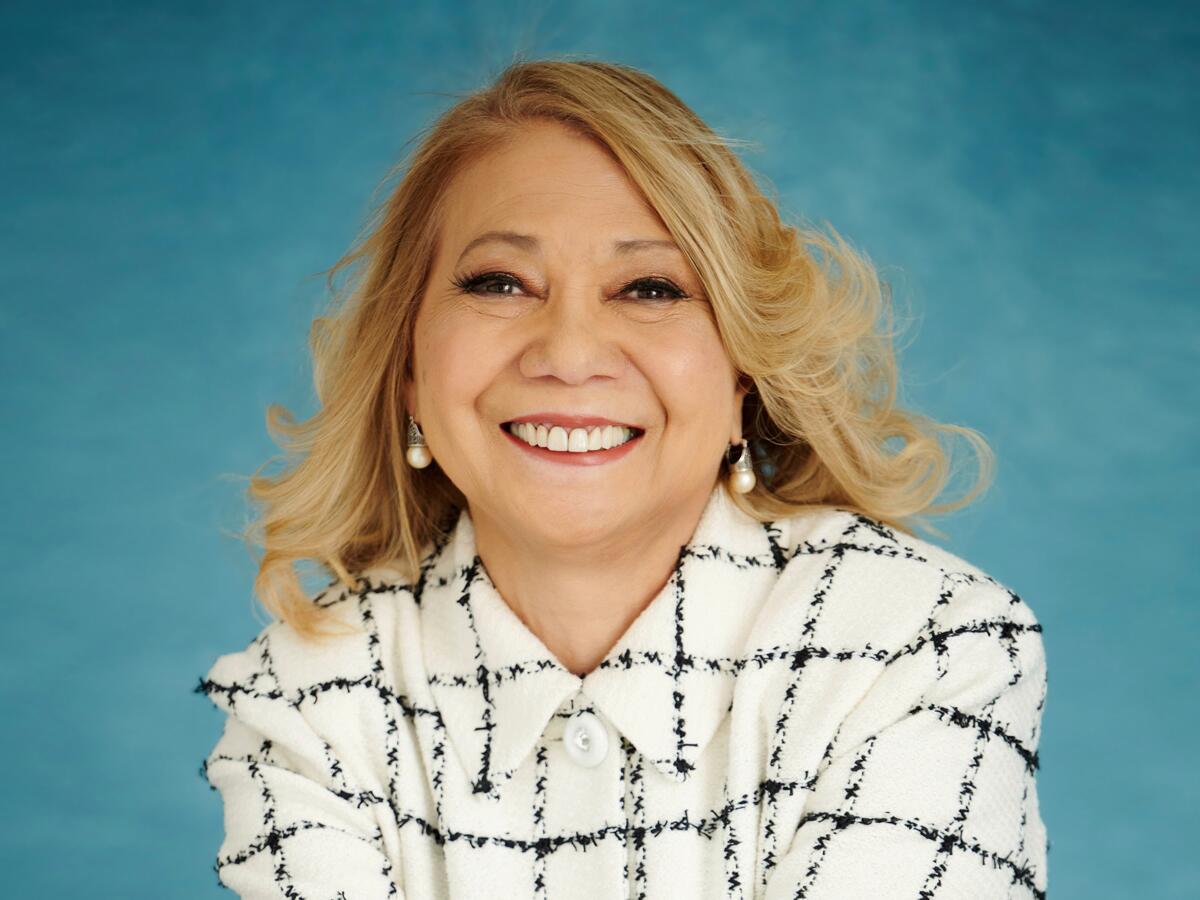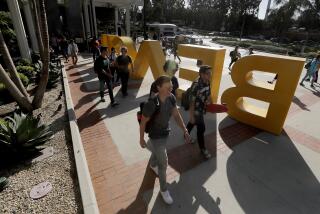Here’s how new CSU Chancellor Mildred García plans to take on a system in crisis

- Share via
Mildred García, named chancellor this week of California State University, will soon take over the largest four-year public university system in the country. But the sprawling 23-campus system, touted as an economic engine for the state and agent of social mobility, is in a moment of crisis.
Investigations by the Los Angeles Times and a report commissioned by the CSU Board of Trustees uncovered widespread flaws in the way the system handles sexual misconduct complaints. Trustees are weighing an annual 6% tuition increase to help bridge a $1.5-billion budget gap. Enrollment fell by more than 26,000 students systemwide between 2017 and 2022, while equity gaps persist.
In an interview hours after her appointment on Wednesday, García discussed how she will take on some of the system’s most urgent issues. Often she answered questions with her own rapid-fire questions, outlining the breadth of issues she intends to explore. She said she will follow through on progress made by work groups assembled to devise solutions for the system, and recommendations from those groups.
Mildred García, who previously served as president at Cal State Dominguez Hills and Cal State Fullerton, will lead the 23-campus system.
She referenced several of these CSU groups, including Graduation Initiative 2025, devoted to boosting graduation rates by 2025. She committed to following through on recommendations in a report by law firm Cozen O’Connor that delivered a sweeping indictment of how sexual misconduct cases are handled by the system, calling for wholesale reforms to improve accountability. And she said she will examine the university’s compliance with Title IX, the federal law that bars discrimination on the basis of sex in education programs that receive federal money.
García, 71, is the former president of Cal State Fullerton and Cal State Dominguez Hills. Earlier in her career, she served as president of Berkeley College, a for-profit college with campuses in New York and New Jersey. She is currently president of the American Assn. of State Colleges and Universities.
The interview has been edited for clarity and brevity.
Q: Why were you interested in serving as chancellor?
Garcia: CSU is the powerhouse of systems in the country. It’s the largest, most diverse system in the United States. They serve the very students that I’ve dedicated my career to. They are a consequential system, educating the most diverse student body — what I call the new majority of America, the first generation, the low-income students of color, and adults — no matter who they are, no matter their background.
Q: What are your priorities?
A: There has been such amazing work being done by the CSU and the five work groups. I was impressed with the collaboration of how they came to recommendations for those reports — may that be the study on African American students and how can we do better, to the Title IX report to looking at students’ success in Graduation Initiative 2025. The first thing I have to do is learn where they are and start to implement those things before I take it somewhere else. You know, the hard work has to be honored and has to be seen, because so many voices were in that work.
Q: How will you fix issues relating to sexual misconduct and Title IX compliance?
They will be a system role to monitor everything that’s going on. I know that our campuses already started implementation teams. There is no strike one, strike two, strike three. There’s strike one. People have to be held accountable for ensuring that we have a caring environment for everybody that works there. And so for me, it’s about who’s responsible for getting that implemented with their teams and making sure it gets done. That’s the job of someone in a position as a president or chancellor, to make sure that once we set a direction of where we’re going, that I make sure that it gets done [and] help in any way I can. At the end of the day, it’s about accountability and making it happen.
Q: CSU is also facing financial challenges. Do you support the 6% tuition increase proposed this week?
A: I have not been fully briefed, so I’m not going to say something without really reviewing and doing that. Look, CSU and all regional comprehensives in this country have a budget problem. Every system is looking at a financial sustainability plan. What I am going to do is make sure that I find out about the financial sustainability plan. What are the options and proposals that are out there? I know there are issues. But so is every regional comprehensive institution in this country. The question is, how do we manage it?
Q: What will you undertake to deal with declining enrollment?
A: Our institutions are regional, comprehensive institutions that are the economic, social and educational hubs of their communities. Each CSU will be different — knowing your mission, who’s in your community, who’s in the high school, who’s in the community colleges? What kind of partnerships do you have? What kind of visibility do you have? What kind of visibility do you have for adults that need to continue their education? What kind of services can you provide? And within your mission, transform yourself as your community is adapting. The enrollment cliff is here in some regions — how do we adapt to that and serve the community that we’ve been established to serve?
Q: What are your biggest career accomplishments?
At Berkeley College, it was helping a board understand the importance of strategic planning and the importance of the academic core and student support services. At Dominguez Hills, they hadn’t met enrollment in eight years. Student services needed some uplifting. And now Dominguez Hills is thriving. And when I left it was thriving. We raised money, an area that was really difficult. At each campus — amazing teams. No president does this alone.
At Fullerton, it was raising graduation rates. It was [narrowing] the opportunity gap. That to me, was a major accomplishment. The two days that I loved the most about being on these campuses was the first day, when [students are] scared and they’re thinking do they belong. Then on graduation, when they’re walking across the stage and you see the families dress in whatever garb they’re representing, cheering them on. Because it’s not only that student, you’re transforming a family.
Q: Can you describe the specific strategies you used to boost graduation and narrow equity gaps?
A: At Dominguez Hills I was the first president that had the vice president for enrollment management reporting directly to me. We started to understand the data, started to understand where were the problems — from not losing transcripts to making sure that students are treated well and our student support services were excellent. We got an enrollment plan, we held people accountable.
At Fullerton, I put together a commission of my provost and my vice president of student affairs to co-chair the task force of student success. It was a team. They came up with this great idea of student success teams at each college. They were able to see the data. We learned that about 30% of students fail one course in their first semester. We learned and we understood that low-income, first-gen students of color — when they fail that course they think they’re a failure, because sometimes they think they don’t even belong there. Reaching out and talking to students, reaching out and texting those students, telling them, “We’re here for you.” Start to show the students that you care, and that you’re helping them along the way.
Q: Many students struggle to meet their basic needs — paying rent, food insecurity. How do you think the university can help?
We do have food insecurity pantries on our campuses. We’re with dealing with mental health — which is an issue for all students across this country. How does each campus deal with it? If you’re in an urban place — how are we partnering with those agencies that are doing good work and that can help those students? That’s one thing.
Other areas, we’ll have to think about, OK — how do we work with maybe businesses? Every business has something that they do with the community. How can we partner with those businesses and the corporations and have them give back to the community in which they’re anchored? Those are the kinds of examples that we have to get out there and see what works for each campus. Each community is different. What happens at Sacramento is different than what happens at Humboldt, is different than what happens at Los Angeles.
Q: How would you define success in this role?
A. We would close the equity gap, or at least get very close. We would graduate more students. And my big dream, which I know is very difficult, but if you don’t dream it doesn’t happen — is to somehow, some way be able to track the 120,000 students we graduated this year and know what they’re doing next and that we helped them get there. I am tired of hearing in Washington, D.C., some legislators telling me that people don’t need a bachelor’s degree anymore because they work at Walmart and Starbucks for minimum wage. I’m tired of that. I want the data. I want to demonstrate — actually show the power of the CSU.
Q: Is there anything else that you’d like to add?
A: The CSU to me is really the role model of the nation on how to educate diverse students. No one is perfect. If we keep students at the center and support our faculty and staff, and make sure that we work within our communities, we can be even more successful. That’s what I’ll be striving for.
More to Read
Sign up for Essential California
The most important California stories and recommendations in your inbox every morning.
You may occasionally receive promotional content from the Los Angeles Times.












